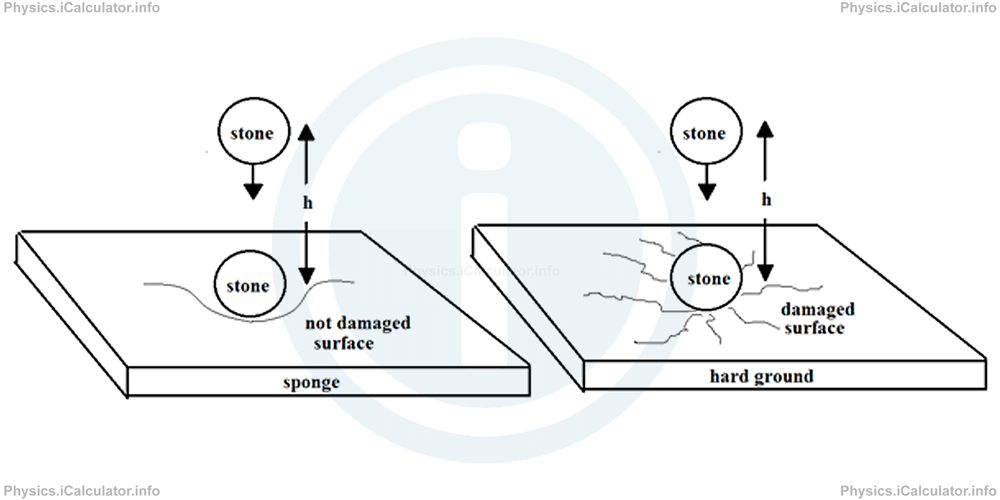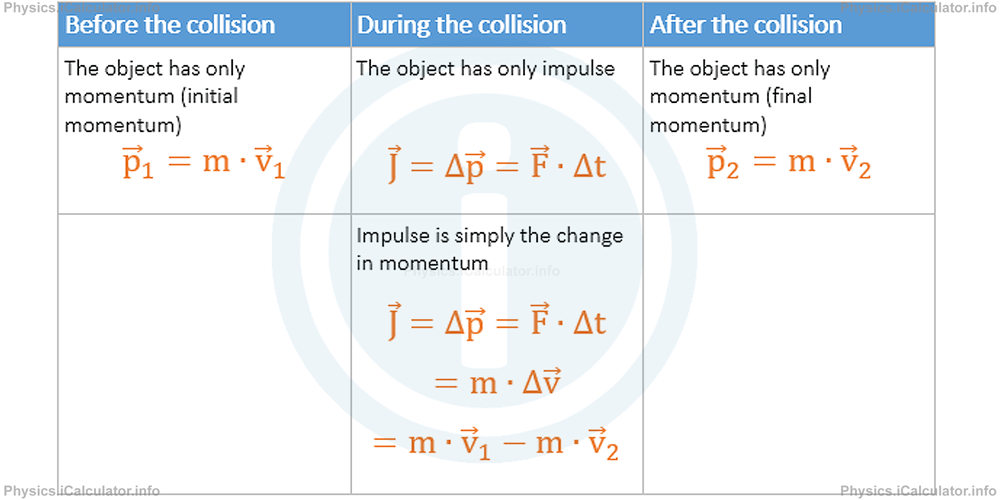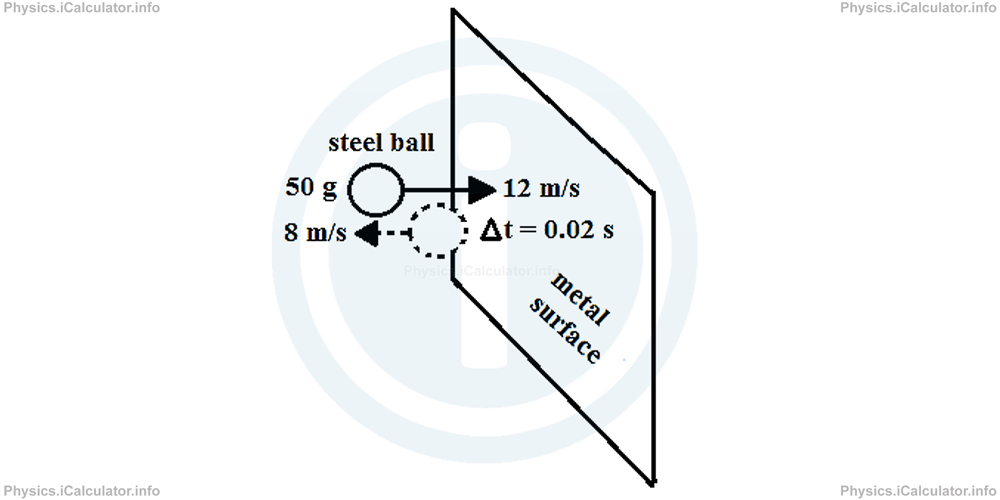Menu
Physics Lesson 6.6.1 - The Meaning of Impulse
Please provide a rating, it takes seconds and helps us to keep this resource free for all to use
Welcome to our Physics lesson on The Meaning of Impulse, this is the first lesson of our suite of physics lessons covering the topic of Collision and Impulse. Types of Collision, you can find links to the other lessons within this tutorial and access additional physics learning resources below this lesson.
The Meaning of Impulse
Let's try to answer the above questions. Thus, apparently, it looks like both objects have experienced the same change in momentum, as since both of them fall down from the same height, their velocity near the ground is equal. On the other hand, they have a zero momentum after the collision, as both of them stop moving after hitting the ground.
However, it is obvious the balls have experienced different processes during their contacts with the respective surfaces. The collision of the first ball (the one that falls on a hard ground) causes a greater impact on both the ball and the ground as they may be easily damaged. On the other hand, the collision with the sponge does not cause any harm in any of the objects in contact as it is "amortized" i.e. absorbed by sponge's softness. Hence, the collision is slower and more extended in time compared to the first case due to the elastic properties of sponge. Look at the figure:

But what can we say about the collision force? Is it the same in both cases?
To answer this question, let's transform the equation of the change in momentum we obtained in the previous tutorial, "Linear Momentum". We have:
Equation 1
∆p⃗ = p⃗1 - p⃗2= m × v⃗1 - m × v⃗2
= m × ∆v⃗
If we divide both sides of the above equation by the collision interval Δt, we obtain
From Kinematics, we know that
where a⃗ is the acceleration of the object. Therefore, we obtain after substitutions
Equation 2
∆⃗p/∆t = m × a⃗The right side of the equation (2) represents the right side of the Newton's Second Law of Motion,
Equation 3
F⃗ = m × a⃗where F⃗ is the force of collision. Therefore, combining the left sides of equations (2) and (3), we obtain
Equation 4
F⃗ = ∆⃗p/∆tThe equation (4) therefore represents another way of writing the Newton's Second Law of Motion. If we transform the equation (4) into
Equation 5
J⃗ = ∆p⃗ = F⃗ × ∆twe obtain a new concept known as "Impulse" which represents the relationship between the change in momentum, collision force and time interval during which the collision occurs. Impulse is denoted by J⃗ and it is a vector quantity as it is obtained by subtracting two vectors. Therefore, an object has an impulse only during the collision while before and after the collision it has only momentums. The following table clarifies this point:

Impulse as a change in momentum has the same unit as momentum, i.e. kg × m / s. In many textbooks, the concept of force is not expressed in its traditional form, i.e. Force = Mass ×; Acceleration based on Newton's Second Law of Motion, but is the form of equation (4), i.e. in terms of impulse and the collision interval.
Now, let's return to the question regarding the collision force, i.e. whether it is the same in both cases mentioned above or not. When the object falls on hard ground, it jumps immediately after the impact, although this jump may be very small to be noticeable for our eyes. This means the impact interval is very short and therefore, the force is big. On the other hand, when the object falls on a soft surface such as a sponge, it takes a much longer to it pushing the surface and reach the bottom. Therefore, as force and collision interval are inversely proportional to each other, the impact force when the object falls on a soft ground is much smaller than when the same object falls on hard ground.
Example 1
A 50 g steel ball hits a metal surface at 12 m/s and bounces back at 8 m/s. the ball is in contact with the metal surface for 0.02 s as shown in the figure.

What is the force of collision between the steel ball and the metal surface?
Solution 1
The ball changes direction after the collision, so we must take its final velocity as negative. As for the other clues, we must not forget to convert the mass of the ball from 50 g into 0.05 kg.
Given the relationship between the change in momentum and impulse, we have
Substituting the known values, we obtain
F⃗ × 0.02 = 0.6 + 0.4
F⃗ × 0.02 = 1
F⃗ = 1/0.02 = 50 N
The direction of force depends on what we are concerned for. If we want to know the force by which the ball hits the metal surface, it is easy to find that in the specific case, it is due right. On the other hand, the force by which the metal reacts to the ball is 50 N as well but due left, based on the action-reaction principle.
You have reached the end of Physics lesson 6.6.1 The Meaning of Impulse. There are 4 lessons in this physics tutorial covering Collision and Impulse. Types of Collision, you can access all the lessons from this tutorial below.
More Collision and Impulse. Types of Collision Lessons and Learning Resources
Whats next?
Enjoy the "The Meaning of Impulse" physics lesson? People who liked the "Collision and Impulse. Types of Collision lesson found the following resources useful:
- Definition Feedback. Helps other - Leave a rating for this definition (see below)
- Centre of Mass and Linear Momentum Physics tutorial: Collision and Impulse. Types of Collision. Read the Collision and Impulse. Types of Collision physics tutorial and build your physics knowledge of Centre of Mass and Linear Momentum
- Centre of Mass and Linear Momentum Revision Notes: Collision and Impulse. Types of Collision. Print the notes so you can revise the key points covered in the physics tutorial for Collision and Impulse. Types of Collision
- Centre of Mass and Linear Momentum Practice Questions: Collision and Impulse. Types of Collision. Test and improve your knowledge of Collision and Impulse. Types of Collision with example questins and answers
- Check your calculations for Centre of Mass and Linear Momentum questions with our excellent Centre of Mass and Linear Momentum calculators which contain full equations and calculations clearly displayed line by line. See the Centre of Mass and Linear Momentum Calculators by iCalculator™ below.
- Continuing learning centre of mass and linear momentum - read our next physics tutorial: Law of Conservation of Momentum and Kinetic Energy
Help others Learning Physics just like you
Please provide a rating, it takes seconds and helps us to keep this resource free for all to use
We hope you found this Physics lesson "Collision and Impulse. Types of Collision" useful. If you did it would be great if you could spare the time to rate this physics lesson (simply click on the number of stars that match your assessment of this physics learning aide) and/or share on social media, this helps us identify popular tutorials and calculators and expand our free learning resources to support our users around the world have free access to expand their knowledge of physics and other disciplines.